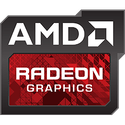Friday, September 16th 2016

AMD Actively Promoting Vulkan Beyond GPUOpen
Vulkan, the new-generation cross-platform 3D graphics API governed by the people behind OpenGL, the Khronos Group, is gaining in relevance, with Google making it the primary 3D graphics API for Android. AMD said that it's actively promoting the API. Responding to a question by TechPowerUp in its recent Radeon Technology Group (RTG) first anniversary presser, its chief Raja Koduri agreed that the company is actively working with developers to add Vulkan to their productions, and optimize them for Radeon GPUs. This, we believe, could be due to one of many strategic reasons.
First, Vulkan works inherently better on AMD Graphics CoreNext GPU architecture because it's been largely derived from Mantle, a now defunct 3D graphics API by AMD that brings a lot of "close-to-metal" API features that make game consoles more performance-efficient, over to the PC ecosystem. The proof of this pudding is the AAA title and 2016 reboot of the iconic first-person shooter "Doom," in which Radeon GPUs get significant performance boosts switching from the default OpenGL renderer to Vulkan. These boosts aren't as pronounced on NVIDIA GPUs.Second, and this could be a long shot, but the growing popularity of Vulkan could give AMD leverage over Microsoft to steer Direct3D development in areas that AMD GPUs are inherently good at - these include asynchronous compute, and tiled-resources (AMD GPUs benefit due to higher memory bandwidths). AMD has been engaging aggressively with game studios working on AAA games that use DirectX 12, and thus far AMD GPUs have been either gaining or sustaining performance better than NVIDIA GPUs, when switching from DirectX 11 fallbacks to DirectX 12 renderers.
AMD has already "opened" up much of its GPU IP to game developers through its GPUOpen initiative. Here, developers will find detailed technical resources on how to take advantage of not just AMD-specific GPU IP, but also some industry standards. Vulkan is among the richly differentiated resources AMD is giving away through the initiative.
Vulkan still has a long way to go before it becomes the primary API in AAA releases. To most gamers who don't tinker with advanced graphics settings, "Doom" still works on OpenGL. and "Talos Prinicple," works on Direct3D 11 by default, for example. It could be a while before a game runs on Vulkan out of the box, and the way its special interest group Khronos, and more importantly AMD, promote its use, not just during game development, but also long-term support, will have a lot to do with it. A lot will also depend on NVIDIA, which holds about 70% in PC discrete GPU market share, to support the API. Over-customizing Vulkan would send it the way of OpenGL. Too many vendor-specific extensions to keep up drove game developers to Direct3D in the first place.
First, Vulkan works inherently better on AMD Graphics CoreNext GPU architecture because it's been largely derived from Mantle, a now defunct 3D graphics API by AMD that brings a lot of "close-to-metal" API features that make game consoles more performance-efficient, over to the PC ecosystem. The proof of this pudding is the AAA title and 2016 reboot of the iconic first-person shooter "Doom," in which Radeon GPUs get significant performance boosts switching from the default OpenGL renderer to Vulkan. These boosts aren't as pronounced on NVIDIA GPUs.Second, and this could be a long shot, but the growing popularity of Vulkan could give AMD leverage over Microsoft to steer Direct3D development in areas that AMD GPUs are inherently good at - these include asynchronous compute, and tiled-resources (AMD GPUs benefit due to higher memory bandwidths). AMD has been engaging aggressively with game studios working on AAA games that use DirectX 12, and thus far AMD GPUs have been either gaining or sustaining performance better than NVIDIA GPUs, when switching from DirectX 11 fallbacks to DirectX 12 renderers.
AMD has already "opened" up much of its GPU IP to game developers through its GPUOpen initiative. Here, developers will find detailed technical resources on how to take advantage of not just AMD-specific GPU IP, but also some industry standards. Vulkan is among the richly differentiated resources AMD is giving away through the initiative.
Vulkan still has a long way to go before it becomes the primary API in AAA releases. To most gamers who don't tinker with advanced graphics settings, "Doom" still works on OpenGL. and "Talos Prinicple," works on Direct3D 11 by default, for example. It could be a while before a game runs on Vulkan out of the box, and the way its special interest group Khronos, and more importantly AMD, promote its use, not just during game development, but also long-term support, will have a lot to do with it. A lot will also depend on NVIDIA, which holds about 70% in PC discrete GPU market share, to support the API. Over-customizing Vulkan would send it the way of OpenGL. Too many vendor-specific extensions to keep up drove game developers to Direct3D in the first place.

111 Comments on AMD Actively Promoting Vulkan Beyond GPUOpen
Also we have to count the durability. I had a hd5870 back in 2009 and sold it in 2012 to a friend and it has been heavily used until last month, the card has been retired but is still working fine. I doubt it would have last that much if I decided to go the gtx470/480 route like I was thinking at first. I know this depends on much more factors than the power consumption but you know how much electricity the gtx400 series draw and how many overheat problems had.
It can be a deciding factor depending on the preferences. For each their own.
Think plain old assembler: nobody has ever started a flame war over Intel not being built for x86_64. It's the responsibility of each program to use the proper code path for the underlying hardware.
Grow up.
(I'm probably going to keep making that joke every time I see "Paxwell" instead of "Maxwell.")
That's good stuff!
I think what you are saying is plausible. But i don't think its anything worth planning for.